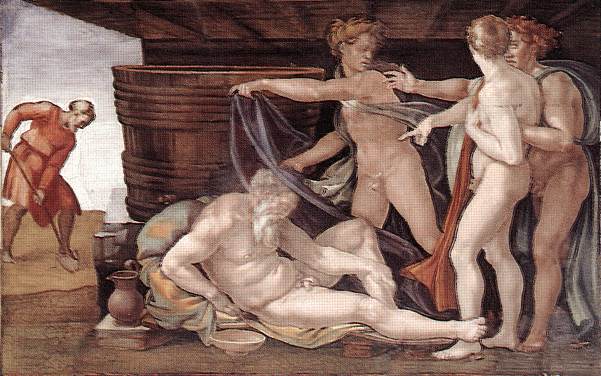
"Ham saw the nakedness of his father, and told his two brethren who were without. An Shem and Japeth took a garment, and laid it out upon both their shoulders, and went backward, covered the nakedness of their father, and their faces were backward, and they saw not their father's nakedness."
Michelangelo evidently neglected the chronological sequence of the Noah series, for Noah's offering should have come directly after the Deluge. Instead, Noah asleep and mocked by his sons is the first fresco that meets the eye as one enters the Chapel through the east door. It occupies a small field between the four ignudi. But the sleeping Patriarch has surely been placed at the end of the first row of frescoes for some good reason. The degradation of the Patriarch, who resembles a Roman river god, and was yet chosen by God to outlive the Flood and ensure the survival and redemption of mankind, was due not to an overdose of wine but to human loss of spiritual memory; to the hypnotic sleep of man oblivious to his origin, enacted here by the father of the race. The sons who stripped and ridiculed him do not know what they are doing and understand neither themselves nor their fate. Noah's devotion and piety pacifies the Father and gives unto God what is God's. For his sake the Eternal has decided to redeem mankind. If the sons mock their father it is their own shame, not his; it is the fall and the inexorable karma of the race which men in their blindness neither see nor understand.
With this biblical motive Michelangelo gives us a blinding insight into his lifelong grief over the human condition. To see in his work nothing but a preoccupation with problems of composition is surely petty and short-sighted. These are self evident and he solved them as best he could, but his main concern was with mankind and his own soul.
The composition, top-heavy on the right, is not altogether a success. The unattractive way in which the face of the son on the extreme right is outlined is a relic of Quattrocento imprecision which the artist will soon discard. Too little emphasis is given to the motive of redemption symbolized by the Beloved of God digging his vineyard to the far left. The vat in the centre dominates the scene like a nightmare.
http://www.wga.hu/frames-e.html?/html/m/michelan/3sistina/1genesis/1drunken/01_3ce1.html





No comments:
Post a Comment